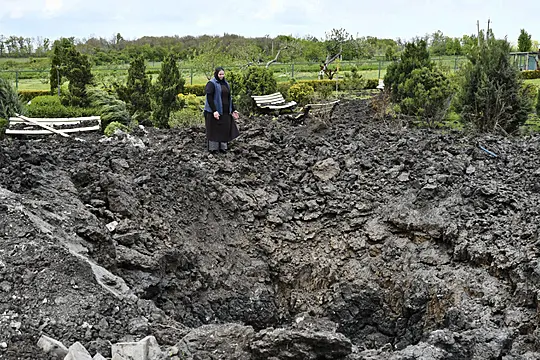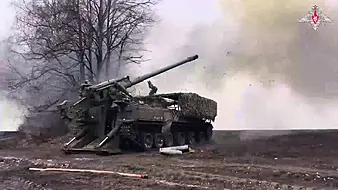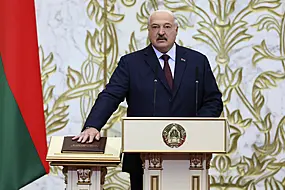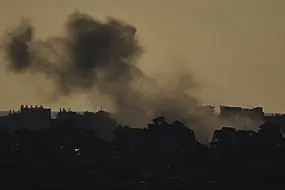Ukraine has stopped the flow of Russian natural gas through one hub that feeds European homes and industry, while a pro-Kremlin official in a southern region seized by Russian troops has said it would ask Moscow to annex it.
The remarks could be another sign of Russia’s broader plan for Ukraine as it tries to salvage an invasion that has so far gone awry – amid concerns that the country may remain a source of continental and global instability for months, or even years, to come.
After his forces failed to quickly overrun the capital Kyiv, President Vladimir Putin shifted his focus to the country’s eastern heartland of the Donbas.
But one of his commanders has suggested that Moscow’s plans are broader, saying it also hopes to take control of the country’s south and cut it off from the coast.
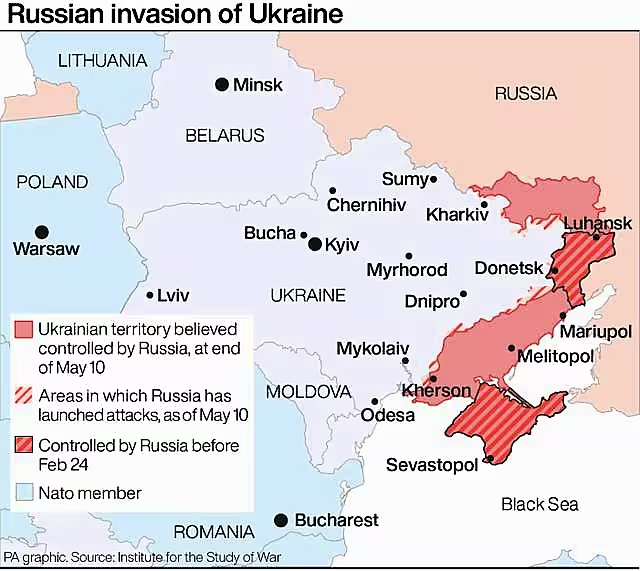
“The city of Kherson is Russia,” Kirill Stremousov, deputy head of the regional administration installed by Moscow, told Russia’s RIA Novosti news agency.
He said regional officials wanted to make Kherson a “proper region” of Russia.
Russian-installed authorities do not always speak for Moscow, but last month Mr Stremousov ruled out returning control of the Kherson region to Ukrainian authorities.
Kherson borders Crimea, which Russia annexed in 2014, and its capture was one of Russia’s most important successes in the war.
In 11 weeks, the war has played out on battlefields in Ukrainian towns and cities but also in energy and financial markets, as Ukraine’s allies in the West have sought to deprive Russia of money needed to fund the war with sanctions and energy embargoes.
The immediate practical impact of Wednesday’s gas cut-off was likely to be limited since much of the gas can be directed through another pipeline, gas analyst Zongqiang Luo at Rystad Energy said.
Preliminary flow data suggested that was already happening, though Russia’s state-owned giant Gazprom indicated some drop in supply.
It said it was sending gas supplies to Europe through Ukraine in the amount of 72 million cubic metres, apparently down 25% from the day before.

The move highlights the broader risk to gas supplies in the war and holds symbolic significance as the first time Ukraine has disrupted the flow westward.
“Yesterday’s decision is a small preview of what might happen if gas installations are hit by live fire and face the risk of extended downtimes,” Mr Luo said.
He added that the interruption would also make it harder for European countries to refill underground storage for next winter and would “hasten Europe’s plans to move away from imports of Russian gas”.
The European Union has sought to reduce its dependence on Russian energy, phasing out its use of coal and considering doing the same for oil.
Gas presents a more complicated problem, given both how much Europe uses and the technical difficulties in sourcing it elsewhere.
It was not clear if Russia would take any immediate hit, since it has long-term contracts and other ways of transporting gas.
On the battlefield, Ukrainian officials said a Russian rocket attack targeted an area around Zaporizhzhia, destroying unspecified infrastructure.
There were no immediate reports of casualties.

The south-eastern city has been a refuge for many civilians who have fled a Russian siege in the devastated port city of Mariupol.
Russian troops also continued to pound the last redoubt of Ukrainian resistance in that city, its defenders said.
The Azov Regiment said on social media on Wednesday that Russian forces carried out 38 air strikes in the last 24 hours “on the territory” of the Azovstal steelworks.
The vast steel mill, with its network of underground tunnels and bunkers, has sheltered hundreds of Ukrainian troops and civilians during a months-long siege.
Scores of civilians were evacuated in recent days, but Ukrainian officials said on Tuesday that some 100 civilians could still be trapped there.
The wives of two Ukrainian soldiers defending the mill met with Pope Francis on Wednesday and asked him to intervene to help arrange for the troops’ evacuation.
One, Yuliia Fedusiuk, said the troops were running out of water and have no food.
She said she understood some civilians, who are relatives of the soldiers, remained in the mill.
Meanwhile, President Volodymyr Zelensky suggested in his nightly address that the military was gradually pushing Russian troops away from Kharkiv – the country’s second largest city, and a key to Russia’s offensive in the Donbas.

He said his troops had driven Russian forces out of four villages near the city.
As his forces appear to gather steam in a nascent counteroffensive, foreign minister Dmytro Kuleba voiced what appeared to be increasing confidence – and expanded goals – on Tuesday.
He suggested to the Financial Times newspaper that Ukraine could go beyond just forcing Russia back to areas it held before the invasion began 11 weeks ago.
Mr Kuleba’s statement seemed to reflect political ambitions more than battlefield realities: Russian forces have made advances in the Donbas and control more of it than they did before the war began.
But it highlights how Ukraine has stymied a larger, better-armed Russian military, surprising many who had anticipated a much quicker end to the conflict.
Meanwhile, the British Ministry of Defence said Ukraine was targeting Russian forces on Snake Island in the north-western Black Sea, in an effort to disrupt Moscow’s attempts to expand its influence.
Russia has sought to reinforce its garrison on Snake Island, while “Ukraine has successfully struck Russian air defences and resupply vessels with Bayraktar drones”, the MoD said on Twitter.
Latest Defence Intelligence update on the situation in Ukraine - 11 May 2022
Find out more about the UK government's response: https://t.co/DjNroJk7jh
🇺🇦 #StandWithUkraine 🇺🇦 pic.twitter.com/iFMlDEKM4T— Ministry of Defence 🇬🇧 (@DefenceHQ) May 11, 2022
It said Russian resupply vessels had minimum protection after the Russian navy retreated to Crimea after losing the flagship of its Black Sea fleet.
Satellite photos analysed by the Associated Press show fighting there.
But the statement warned: “If Russia consolidates its position on (Snake) Island with strategic air defence and coastal defence cruise missiles, they could dominate the northwestern Black Sea.”
Ukraine’s natural gas pipeline operator said it would stop Russian shipments through a hub in a part of eastern Ukraine controlled by Moscow-backed separatists because of interference from “occupying forces”, including the apparent siphoning of gas.
It also complained about interference along the route last month.
Benchmark European gas futures seesawed on Tuesday and Wednesday on the news, meaning consumers may face higher energy bills – at a time of already rising prices.
Higher prices would benefit Russia, though it has massive foreign reserves now thanks to the rapid rise in crude oil prices in recent months as global travel and business resumed in the wake of mass coronavirus pandemic lockdowns.

The hub in question handles about a third of Russian gas passing through Ukraine to western Europe.
Russia’s state-owned natural gas giant Gazprom put the figure at about a quarter.
The move came as western powers have been looking to ratchet up economic pressure on Moscow and bolster Ukraine’s defenders.
The US House of Representatives approved a 40 billion dollar (£32 billion) Ukraine aid package on Tuesday.
US officials and Nato have expressed concerns that Russia may be digging in for a protracted conflict as the war grinds into its third month with little sign of a decisive military victory for either side and no resolution in sight.
The Atlantic alliance is also waiting to see whether Sweden and Finland, two key Baltic Sea neighbours of Russia, would announce plans to join Nato – in what could be a serious blow to Russia.
